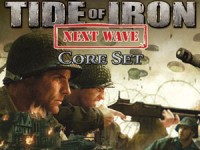
Tide of Iron: Next Wave
2-4
13+
60+
This edition of the Tide of Iron core set replaces to large box, Fantasy Flight edition. The main differences between to the two editions are Next Wave will have reformatted rules and quick-start scenarios to better facilitate new players' entry into the game, slightly reduced components (15 less miniatures 225 vs 240, and less dice 14 vs 20). No rules have been changed and this new core set remains compatible with ALL previously published materials from both Fantasy Flight and 1A Games.
User Reviews (1)
Add a Review for "Tide of Iron: Next Wave"
You must be logged in to add a review.


I started out playing Memoir 44 and have written over sixty scenarios for Memoir. But then my wife bought me Tide of Iron for Valentines Day! I really liked the snap together squads and bases, and the mechanics of play is more strategy and less luck induced. I also liked the ability to activate all of your units in a game turn (or round, as it’s called in TOI). The operations cards may modify your units, or terrain, but they don’t have anything to do with which units are activated. The strategy decks give reinforcements, supply, ground support, air support, artillery support, leadership bonuses, or provide morale. Each turn (round) is divided into three parts; the action phase, the command phase, and the status phase. The action phase is where you move and shoot your miniatures. These rules are fairly simple, if you don’t move and shoot, you roll a number of dice equal to your firepower for the unit that is shooting. If you move and shoot, you roll a number of dice equal to half the firepower rounded up. Or you can assault, where you move into an adjacent hex and fire with full firepower, but the defender in this case gets to fire back. Assaulting is like fighting with everything you’ve got (guns, baynets, fists, ect). When squads (infantry) fires, they can fire standard or suppressive fire. Suppressive fire doesn’t remove figures when successful, but can pin, disrupt, or rout the enemy unit(s). If pinned, they cannot move or fire (unless there is an officer in the same hex), if disrupted, they cannot move or fire for two rounds, and if routed, the whole enemy squad is eliminated from the game (only infantry can be attacked with suppressive fire). Once your unit (squad or vehicle) moves or fires its weapon, you place a fatigued marker next to it so that you know it has no more actions this round (although it can still support an assault on an adjacent hex). Your squads may be specialized with a specialization token. Specialization tokens for the base game include engineers, medics, flamethrower units, and anti-tank units. Heavy weapon units include mortar and machine gun units. The heavy figures take two of the four holes in your squad base, which means you can have two heavy weapon figures, or one and two other figures. There are enough different armored units to make a WWII history buff happy.You may also activate a strategy card during action phase. These might be air support, ground support, artillery support, supply, or other action phase activated strategy card. In the Command Phase, you add up the number on the command objective markers you control and receive that many command tokens. To take a command objective marker, you must have either started on it, or have placed a unit on it and kept it there until the command phase. If you have captured victory objective markers, you receive that many victory points. You then spend your command tokens on cards, or on initiative for the next round. The Status Phase is where you remove all of the fatigued and pinned markers, place units on opportunity fire, transfer standard squad members to empty pegs in a squad in the same hex, and advance the round marker. Then the next round begins!